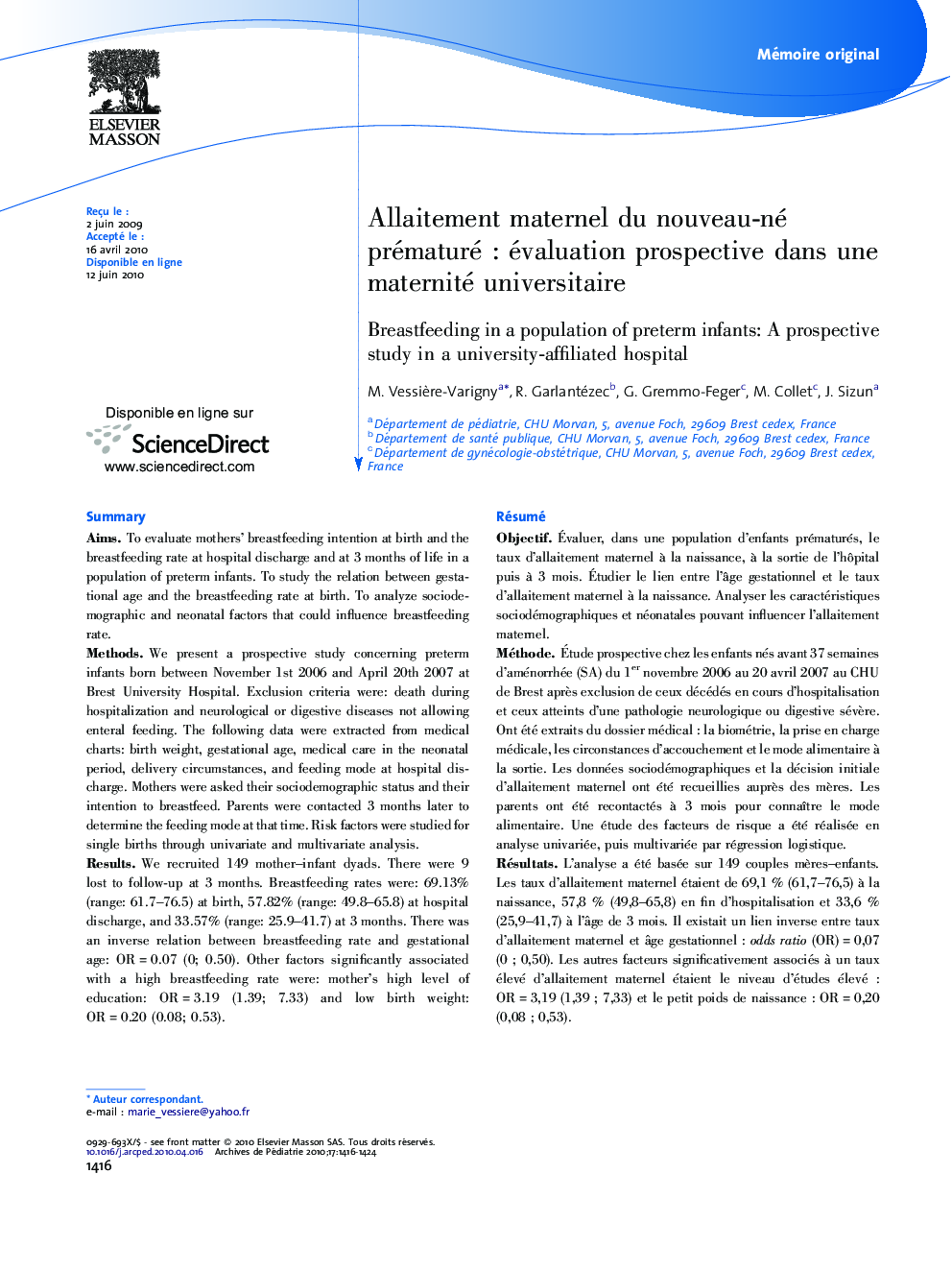| Article ID | Journal | Published Year | Pages | File Type |
|---|---|---|---|---|
| 4148180 | Archives de Pédiatrie | 2010 | 9 Pages |
RésuméObjectifÉvaluer, dans une population d’enfants prématurés, le taux d’allaitement maternel à la naissance, à la sortie de l’hôpital puis à 3 mois. Étudier le lien entre l’âge gestationnel et le taux d’allaitement maternel à la naissance. Analyser les caractéristiques sociodémographiques et néonatales pouvant influencer l’allaitement maternel.MéthodeÉtude prospective chez les enfants nés avant 37 semaines d’aménorrhée (SA) du 1er novembre 2006 au 20 avril 2007 au CHU de Brest après exclusion de ceux décédés en cours d’hospitalisation et ceux atteints d’une pathologie neurologique ou digestive sévère. Ont été extraits du dossier médical : la biométrie, la prise en charge médicale, les circonstances d’accouchement et le mode alimentaire à la sortie. Les données sociodémographiques et la décision initiale d’allaitement maternel ont été recueillies auprès des mères. Les parents ont été recontactés à 3 mois pour connaître le mode alimentaire. Une étude des facteurs de risque a été réalisée en analyse univariée, puis multivariée par régression logistique.RésultatsL’analyse a été basée sur 149 couples mères–enfants. Les taux d’allaitement maternel étaient de 69,1 % (61,7–76,5) à la naissance, 57,8 % (49,8–65,8) en fin d’hospitalisation et 33,6 % (25,9–41,7) à l’âge de 3 mois. Il existait un lien inverse entre taux d’allaitement maternel et âge gestationnel : odds ratio (OR) = 0,07 (0 ; 0,50). Les autres facteurs significativement associés à un taux élevé d’allaitement maternel étaient le niveau d’études élevé : OR = 3,19 (1,39 ; 7,33) et le petit poids de naissance : OR = 0,20 (0,08 ; 0,53).ConclusionLes taux d’allaitement maternel restent très inférieurs aux objectifs recommandés. Une attention particulière doit être apportée aux mères d’enfants faiblement prématurés et à celles ayant un niveau socioéconomique bas.
SummaryAimsTo evaluate mothers’ breastfeeding intention at birth and the breastfeeding rate at hospital discharge and at 3 months of life in a population of preterm infants. To study the relation between gestational age and the breastfeeding rate at birth. To analyze sociodemographic and neonatal factors that could influence breastfeeding rate.MethodsWe present a prospective study concerning preterm infants born between November 1st 2006 and April 20th 2007 at Brest University Hospital. Exclusion criteria were: death during hospitalization and neurological or digestive diseases not allowing enteral feeding. The following data were extracted from medical charts: birth weight, gestational age, medical care in the neonatal period, delivery circumstances, and feeding mode at hospital discharge. Mothers were asked their sociodemographic status and their intention to breastfeed. Parents were contacted 3 months later to determine the feeding mode at that time. Risk factors were studied for single births through univariate and multivariate analysis.ResultsWe recruited 149 mother–infant dyads. There were 9 lost to follow-up at 3 months. Breastfeeding rates were: 69.13% (range: 61.7–76.5) at birth, 57.82% (range: 49.8–65.8) at hospital discharge, and 33.57% (range: 25.9–41.7) at 3 months. There was an inverse relation between breastfeeding rate and gestational age: OR = 0.07 (0; 0.50). Other factors significantly associated with a high breastfeeding rate were: mother's high level of education: OR = 3.19 (1.39; 7.33) and low birth weight: OR = 0.20 (0.08; 0.53).ConclusionOur breastfeeding rates are lower than recommended by WHO. Mothers of late preterm infants or with a low socioeconomic status should benefit from supportive care.
